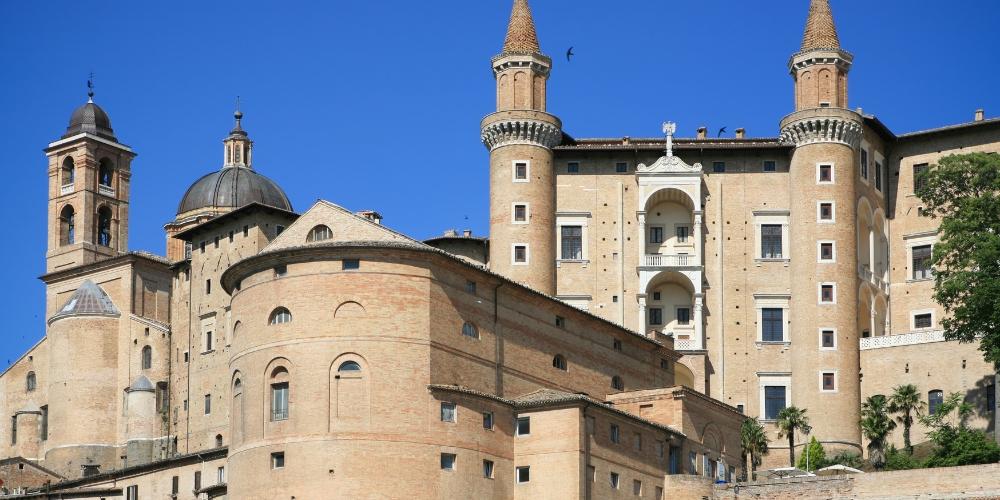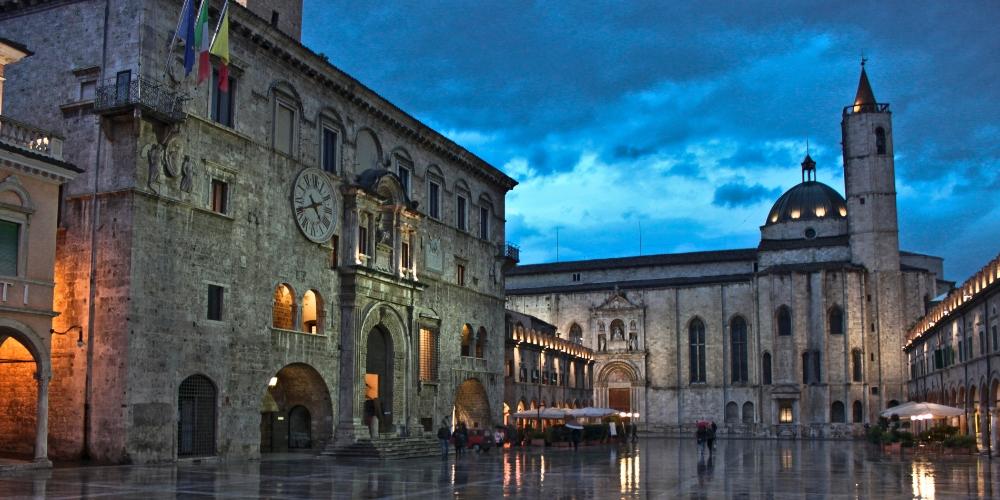Not only Florence. Discover Le Marche's artistic heritage on an unforgettable Renaissance tour.
Not the usual Renaissance tour. You can embark on an astonishing art journey through stops saturated with history and beauty in just a few hours by train from Florence and Rome. Some destinations are famous, and others are there to be rediscovered.
The UNESCO heritage sites, jewel towns, timeless villages, churches and monumental sanctuaries, the art of Piero della Francesca, Carlo Crivelli, Raphael, Lorenzo Lotto, and Titian. Le Marche’s artistic heritage reveals itself little by little as you explore the region.
And there are many ways to explore it. Each corresponds to a key that unlocks its many facets. Here are some of the most iconic places to meet Le Marche’s artistic heritage in an eye-catching Renaissance tour.

Le Marche’s artistic heritage: a renaissance tour among palaces and UNESCO cities

This article is a non-linear itinerary with some travel suggestions in eight essential stages to get a satisfying taste of Le Marche's artistic heritage. Check out our roundup of hints and tips with art as the red thread.
Visit Italy's Renaissance tour begins at Urbino's court, a true capital of the Italian Renaissance. It continues through majestic residences, fortresses that hide incredible stories, sumptuous sanctuaries, and "artistic" landscapes.
We tell you where to look for a small, romantic hidden spectacle in Macerata and reveal how to "enter" one of the most famous paintings of the Uffizi gallery. Also, you are going to find an alternative and fun way to visit Ascoli Piceno.
Here is what we have prepared. Read our suggestions, then go back and click here to learn more about Le Marche’s artistic heritage.
Le Marche’s artistic heritage: Urbino and its Palazzo Ducale

Raphael's hometown, a UNESCO World Heritage Site since 1998, is a true symbol of the Italian Renaissance. On Visit Italy, we have already told you about the spots you shouldn't miss in the city during a holiday. Here you can find more about one of the most significant works of art in the Marche region, a must-see on a Renaissance tour.
The Palazzo Ducale in Urbino dates back to the 15th century. First-class architects and artists took part in its construction. Federico da Montefeltro, a mercenary captain, patron and enlightened lord, commissioned what would be a majestic creation in terms of grace and size, an all-time masterpiece.
Baldassarre Castiglione called it a 'city in the shape of a palace'. Not a traditional fortress but a building of exquisite elegance in which everything - taste, geometry and balance of forms and proportions - refers to the canons of Renaissance harmony.
The Palazzo Ducale is home to the Galleria Nazionale delle Marche, with paintings of great artists such as Piero della Francesca, Raphael and Titian.
Le Marche's Renaissance Tour: Pesaro and the Villa Imperiale
In Pesaro, the sun rises and sets over the sea. You cycle through the beauty of a bike-friendly historic centre and learn to love music in Gioachino Rossini's hometown. Also, you should visit a marvellous residence, a jewel of Renaissance art in Le Marche.
La Villa Imperiale is immersed in the Colle San Bartolo Natural Park. The name pays tribute to its origins: Emperor Frederick III of Habsburg laid the foundation stone in 1469.
This ancient country residence among centuries-old olive trees dates between the 15th and 16th centuries. Commissioned by Alessandro Sforza as a place of recreation and rest, it originally featured the typical elements of a defensive structure, such as battlements and turrets.
The Della Rovere dukes enlarged and frescoed the villa to a design by Gerolamo Genga. The refined Renaissance residence was thus embellished with new rooms, wall paintings and magnificent terraced gardens with water features.
The Villa Imperiale in Pesaro underwent several changes when it was reorganised in the 18th century to house Jesuit monks. Only from the 19th century onwards did a series of restorations give it its former splendour. Visits are allowed from May to October.
Feel like in a painting in Urbania
Urbania is a small town framed by greenery and crossed by the Metauro river. It offers pleasant strolls under its porticoes, a fascinating 'exhibition' of mummies that has attracted National Geographic's attention, jewel-like churches and the marvellous Villa del Barco, the hunting reserve of the lords of Montefeltro.
The Dukes of Urbino equipped it with the monumental Ducal Palace, today home to the Municipal Library, the Art Gallery, the Civic Museum, the Municipal Archives and the Museum of the History of Agriculture and Handicrafts.
All around, the town unfolds a poetic landscape that has inspired notable works of art.
Here we tell you about one place whose coordinates are included (together with six other locations in Montefeltro) in an ideal tour to admire the actual backgrounds of some renowned Renaissance paintings.
In Urbania, you can observe the panorama that inspired Piero della Francesca for his portrait of Federico da Montefeltro preserved in the Uffizi gallery. The Balcony of Ca' Mocetto overlooks the Metauro river plain, with Sant'Angelo in Vado, the Tuscan-Marchigiano Apennines, the two Sassi Simone and Simoncello and Mount Carpegna.
Sassocorvaro and its unique fortress
The Rocca Ubaldinesca was at the centre of an incredible anecdote during the Second World War. Between 1943 and 1944, the fortress was secretly used as a special stone and brick 'coffer' to hide over ten thousand works of art, thus securing them against bombings and raids.
The mighty Renaissance fortification of Sassocorvaro Auditore, in the province of Pesaro and Urbino, dominates the village and the surrounding Foglia river valley. It's a must-see destination to learn more about Le Marche’s artistic heritage.
The 15th-century rocca is a masterpiece of military architecture by Francesco di Giorgio Martini, who designed it with the shape of a tortoise. Anyway, to catch the similarity with the reptile, you need to look at the plan.
Inside, the Museo della Rocca houses paintings, sculptures and period furniture dating from the 14th to the 19th century.
The Bonafede Palace of Monte San Giusto
Nicolò Bonafede, bishop of Chiusi, condottiere and patron of the arts, had Palazzo Bonafede built in Monte San Giusto as a symbol of prestige. It became one of the most splendid examples of Italian Renaissance architecture, an ambitious project by Antonio da Sangallo the Younger, the architect of the popes.
The brick façade displays Guelph windows and a portal carved in Istrian stone celebrating Nicolò's exploits. The interior reveals a series of frescoes and valuable paintings. A portrait by Luigi Fontana depicting Bonafede viewing the palace's design is displayed in the council chamber.
Today, in addition to being the municipal seat of Monte San Giusto, the 16th-century palace houses the Alessandro Maggiori Centre, whose collection includes ancient drawings by major Renaissance artists.
Loreto and its fortress basilica

In 1469, Pope Paul II became interested in building a large basilica around a treasure of Catholic spirituality. The tiny brick house where, according to faith, the Virgin Mary received the annunciation of Jesus' birth was not far from Ancona.
The town of Loreto would developed after the construction of the new religious complex, soon to become a pilgrimage destination.
Great names in art and architecture of the time, from Bramante to Antonio da Sangallo, were involved in the project, while the beautiful bell tower is an 18th-century creation by Luigi Vanvitelli.
Inside the basilica is the small holy dwelling of Palestinian origin, whose outer walls were covered with refined marble bas-reliefs in the 16th century. The building sits below the vast frescoed dome, which was among the world's largest at the time.
Surprisingly, the mighty walls surrounding the Marian shrine almost make it look like a fortress. Today, walking along the ancient patrol walkways used in the past to ward off enemy attacks will allow you to take advantage of the marvellous panorama surrounding the citadel.
Macerata and its astronomical clock
The city centre, rounding hills and the Adriatic sea. Climb the Civic Tower of Macerata, and you'll see a decidedly impressive panorama at a remarkable height of 64 metres. But the view of the beautiful landscape of the Marche region is not the only attraction of this building, constructed between 1492 and 1653 and towering in Piazza della Libertà.
On its base is a work of Renaissance mechanics that has no equal in the world. It's a splendid planetary clock that faithfully reproduces the 16th-century original.
The large blue dial represents the solar system's planets and shows not only the time but also the moon phases and the movement of the celestial bodies.
Go and see it at 12 noon or 6 p.m. to watch the carousel formed by the Three Kings and the Madonna and Child looking out from the two small doors above the clock. A secret and romantic spectacle.
In Ascoli Piceno, among speaking palaces

Piazza del Popolo, surrounded by a scenic vaulted arcade, with the Basilica of San Francesco, the Palazzo dei Capitani and the café beloved by Sarte and Hemingway, is a perfect example of Renaissance architectural harmony blending with the ancient medieval core of Ascoli Piceno.
For the 'city of a hundred towers', the Renaissance was a time of cultural ferment and flourishing. We suggest you relive it with an eye on the travertine covering squares and buildings. A 'speaking' stone that tells a lot about the city spirit: walking along Via Soderini and Corso Mazzini, you'll understand why.
Did you know that the façades of churches and houses in Ascoli Piceno are often furrowed with engravings? Ironic, wise, irreverent, religiously inspired: each one reflects the spirit of the ancient inhabitants who decided to engrave them, sometimes right at the entrance to their residences.
A curious custom widespread between the 14th and 16th centuries. Look around and read what is written on the lintels as you stroll through historic palaces. Le Marches’s artistic heritage knows how to surprise.



